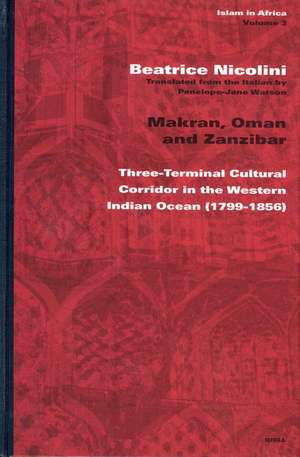Makran, Oman and Zanzibar: Three-Terminal Cultural Corridor in the Western Indian Ocean (1799-1856): Islam in Africa, cartea 3
Autor Beatrice Nicolinien Limba Engleză Hardback – 14 apr 2004
Din seria Islam in Africa
- 18%
 Preț: 721.44 lei
Preț: 721.44 lei - 18%
 Preț: 1374.54 lei
Preț: 1374.54 lei - 18%
 Preț: 598.44 lei
Preț: 598.44 lei - 18%
 Preț: 868.62 lei
Preț: 868.62 lei - 18%
 Preț: 869.33 lei
Preț: 869.33 lei - 18%
 Preț: 888.01 lei
Preț: 888.01 lei - 18%
 Preț: 696.64 lei
Preț: 696.64 lei - 18%
 Preț: 635.76 lei
Preț: 635.76 lei - 22%
 Preț: 678.05 lei
Preț: 678.05 lei - 18%
 Preț: 723.40 lei
Preț: 723.40 lei - 18%
 Preț: 576.05 lei
Preț: 576.05 lei - 18%
 Preț: 610.42 lei
Preț: 610.42 lei - 18%
 Preț: 635.13 lei
Preț: 635.13 lei - 18%
 Preț: 590.65 lei
Preț: 590.65 lei - 18%
 Preț: 591.20 lei
Preț: 591.20 lei - 18%
 Preț: 682.98 lei
Preț: 682.98 lei - 18%
 Preț: 722.09 lei
Preț: 722.09 lei - 18%
 Preț: 683.69 lei
Preț: 683.69 lei - 18%
 Preț: 810.09 lei
Preț: 810.09 lei - 18%
 Preț: 649.55 lei
Preț: 649.55 lei - 18%
 Preț: 598.27 lei
Preț: 598.27 lei
Preț: 591.58 lei
Preț vechi: 721.44 lei
-18% Nou
Puncte Express: 887
Preț estimativ în valută:
113.23€ • 117.76$ • 94.89£
113.23€ • 117.76$ • 94.89£
Carte indisponibilă temporar
Doresc să fiu notificat când acest titlu va fi disponibil:
Se trimite...
Preluare comenzi: 021 569.72.76
Specificații
ISBN-13: 9789004137806
ISBN-10: 9004137807
Pagini: 180
Dimensiuni: 167 x 245 x 19 mm
Greutate: 0.52 kg
Editura: Brill
Colecția Brill
Seria Islam in Africa
ISBN-10: 9004137807
Pagini: 180
Dimensiuni: 167 x 245 x 19 mm
Greutate: 0.52 kg
Editura: Brill
Colecția Brill
Seria Islam in Africa
Public țintă
All readers curious about a new history of Oman and Zanzibar and European relationships during the first half of the 19th century. Accurate bibliographical references will be useful to scholars.Notă biografică
Beatrice Nicolini, Ph.D. (1995) in History of Africa, is Assistant Professor of History and Institutions of Africa, Faculty of Political Sciences, at the Catholic University, Milan, Italy. She has published several essays and monograph studies on History of South-Central Asia and Sub-saharan East Africa translated also in Arabic.
Recenzii
'…the general reader will enjoy its well-crafted narrative and accessible overview of Makran and Swahili cultures and histories.'
James R. Brennan, Tanzanian Affairs, 2005.
James R. Brennan, Tanzanian Affairs, 2005.
Cuprins
PART I
Chapter One The Western Indian Ocean Idyll,
1.1 Makran: ‘Terra Incognita’,
1.2 British descriptions of 19th Century’s Muscat,
1.3 Sub-Saharan East Africa’s Terminus,
1.4 Tribes and Trade Interfaces
Chapter Two The Maritime Routes to East Africa, 2.1 Indian Merchant Communities,
2.2 Why Zanzibar?,
2.3 Magic East African Practices,
2.4 Luxury Goods,
2.5 Europeans in Zanzibar
Chapter Three Zanzibar and Swahili Coast: Land, Power Groups and Social Classes,
3.1 Swahili Origins,
3.2 Swahili Urban Landscape,
3.3 Landed Property and Social Stratification
PART II
Chapter Four The Anglo-French Rivalry: The Rise of Zanzibar (1799–1810),
4.1 Sul†an bin A˙mad Al Bu Sa"idi (1792–1804): TheFather of the First Sultan of Zanzibar,
4.2 Napoleon and the ‘Intercepted Letters’,
4.3 Sa"id bin Al Bu Sa"idi and the British Conquest of the Île de France/Mauritius (1810),
4.4 The Memoranda of J.S. Buckingham: A Portrait of Sa"id bin Sul†an Al Bu Sa"idi,
4.5 David Vatrin and Vincenzo Maurizi, Two ItalianSpies in the Indian Ocean?
Chapter Five Slave Trade and British Abolition Policy,
5.1 Slaves,
5.2 Ivory and Spices,
5.3 The Swahili Coast and the Hinterland,
5.4 British View of Sa"id bin Sul†an Al Bu Sa"idi
Chapter Six The Moresby Treaty (4/22 September 1822),
6.1 United States of America and Zanzibar,
6.2 Sa"id bin Sul†an Al Bu Sa"idi and Atkins Hamerton
Conclusions
Appendix—Coins in use
Sources and Bibliography,
1. Archive Sources—Manuscripts,
2. Printed Sources,
3. Published Primary Sources,
4. Secondary Sources, Glossary
Notes on the Index
Index of Names
Index of Places
Chapter One The Western Indian Ocean Idyll,
1.1 Makran: ‘Terra Incognita’,
1.2 British descriptions of 19th Century’s Muscat,
1.3 Sub-Saharan East Africa’s Terminus,
1.4 Tribes and Trade Interfaces
Chapter Two The Maritime Routes to East Africa, 2.1 Indian Merchant Communities,
2.2 Why Zanzibar?,
2.3 Magic East African Practices,
2.4 Luxury Goods,
2.5 Europeans in Zanzibar
Chapter Three Zanzibar and Swahili Coast: Land, Power Groups and Social Classes,
3.1 Swahili Origins,
3.2 Swahili Urban Landscape,
3.3 Landed Property and Social Stratification
PART II
Chapter Four The Anglo-French Rivalry: The Rise of Zanzibar (1799–1810),
4.1 Sul†an bin A˙mad Al Bu Sa"idi (1792–1804): TheFather of the First Sultan of Zanzibar,
4.2 Napoleon and the ‘Intercepted Letters’,
4.3 Sa"id bin Al Bu Sa"idi and the British Conquest of the Île de France/Mauritius (1810),
4.4 The Memoranda of J.S. Buckingham: A Portrait of Sa"id bin Sul†an Al Bu Sa"idi,
4.5 David Vatrin and Vincenzo Maurizi, Two ItalianSpies in the Indian Ocean?
Chapter Five Slave Trade and British Abolition Policy,
5.1 Slaves,
5.2 Ivory and Spices,
5.3 The Swahili Coast and the Hinterland,
5.4 British View of Sa"id bin Sul†an Al Bu Sa"idi
Chapter Six The Moresby Treaty (4/22 September 1822),
6.1 United States of America and Zanzibar,
6.2 Sa"id bin Sul†an Al Bu Sa"idi and Atkins Hamerton
Conclusions
Appendix—Coins in use
Sources and Bibliography,
1. Archive Sources—Manuscripts,
2. Printed Sources,
3. Published Primary Sources,
4. Secondary Sources, Glossary
Notes on the Index
Index of Names
Index of Places
